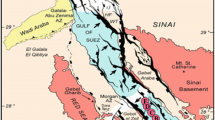Abstract
In order to improve the reservoir description phase in extensively recognized oil fields, a methodology, combining geostatistics, multivariate data analysis, and appropriate geological reasoning, was developed. This methodology involves several steps: (i) Splitting the variable set available on each well into two subsets, with different intrinsic meaning—the “principal” and the “supplementary” variables. The former summarize oil-quality distribution, and supplementary variables are chosen to reproduce some geological/petrophysical characteristics of the reservoir. (ii) Application of Correspondence Analysis to the disjunctive table recoding all data in categorical form, using arbitrary class limits for quantitative variables. (iii) Selection of “final” class limits by visualization of supplementary projections onto the factorial plane and by contiguity analysis of groups in the well-location map. Groups of wells are arranged in decreasing order of their average oil-quality distribution, given by an index, which is the projection onto factor 1 of correspondence analysis. (iv) Establishment of Reservoir Quality Zones (RQZ), being a zone defined as a set of embedded groups, displaying spatial contiguity. The oil-quality index of a given zone is greater than a certain limit, which is related to fluids saturation, spatial distribution of net oil column and petrophysical characteristics of the zone. (v) Estimation of boundaries for each zone through Transitive Kriging of indicator data. (vi) Oil-in-place volume calculation for each zone, combining the geometrical estimation approach with Universal Kriging. Steps (i)–(iv) are applied interactively, using a case study for illustration purposes. Some consequences of horizontal zonation on production planning are discussed, focusing on the improvement of the reservoir description phase, brought by the proposed methodology.
Similar content being viewed by others
References
Alfaro M., Miguez, F., 1976, Optimal Interpolation Using Transitive Methods:in Guarascio et al. (Eds.), Advanced Geostatistics in the Mining Industry. Reidel, Dordrecht, Holland, p. 91–99.
Benzécri, J.-P, 1973, L'Analyse des Données, tome 2, L'Analise des Correspondences: Dunod, Paris, 619 p.
Benzécri, J.-P., 1980, Pratique de l'analise des données Abregé Théorique, Cas Modéle, Vol. 2: Dunod, Paris, 466 p.
Benzécri, J.-P., 1983, Histoire et préhistoire de l'analyse des données: Dunod, Paris, 159 p.
Bertrand, R., Desjardins, M., and Kubler, B., 1981, Application de l'analyse factorielle des correspondences aux gas adsorbés de l'offshore du Labrador: Can. J. Earth Sc., v. 18, p. 509–517.
Bonham-Carter, G., Gradstein, F., and D'Orio, M., 1986, Distribution of Cenozoic Foraminifera from the Northwestern Atlantic Margin Analysed by Correspondence Analysis: Comput. Geosci., v. 12, p. 621–635.
Greenacre, M., 1984, Theory and Applications of Correspondence Analysis: Academic Press, London, 364 p.
Matheron, G., 1978. Estimer et Choisir, CGMM, Fontainebleau, 175 p.
Pereira, H. Garcia, Costa e Silva, A., Ribeiro, L., and Guerreiro, L., 1989, Estimation of Reserves at Different Phases in the History of an Oil Field:in Armstrong, M. (Ed.), Geostatistics, Vol. 2, Kluwer Academic Publishers, p. 543–555.
Teil, H., 1975, Correspondence Factor Analysis: An Outline of the Method: Math. Geol., v. 7, p. 3–12.
Zhou, D., Chang, T., and Davis, J. C., 1983, Dual Extraction of R-Mode and Q-Mode Factor Solutions: Math. Geol., v. 15, p. 581–606.
Author information
Authors and Affiliations
Rights and permissions
About this article
Cite this article
Pereira, H.G., Costa e Silva, A., Soares, A. et al. Improving reservoir description by using geostatistical and multivariate data analysis techniques. Math Geol 22, 879–913 (1990). https://doi.org/10.1007/BF00890116
Received:
Accepted:
Issue Date:
DOI: https://doi.org/10.1007/BF00890116



